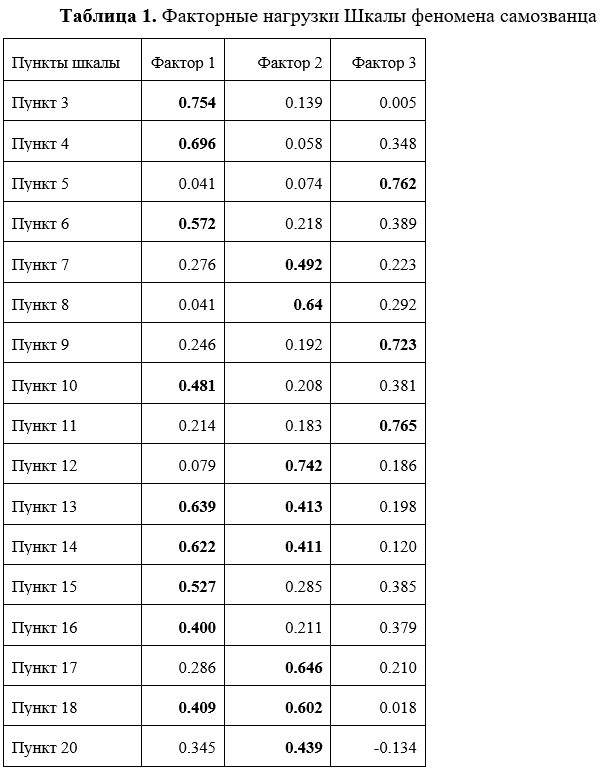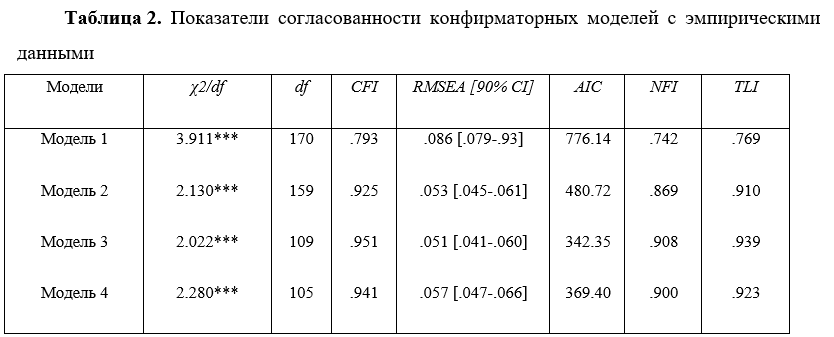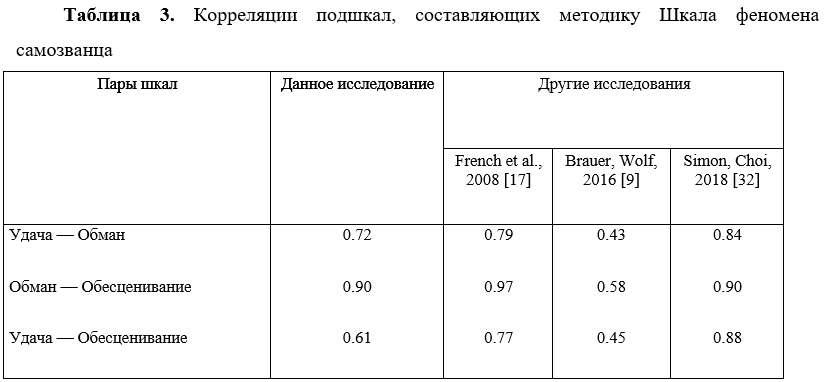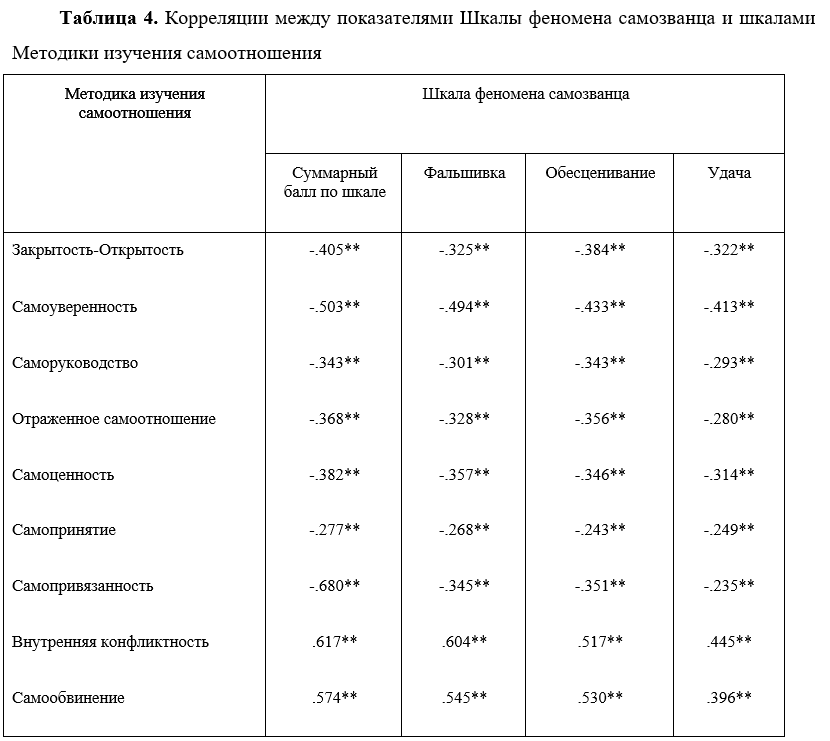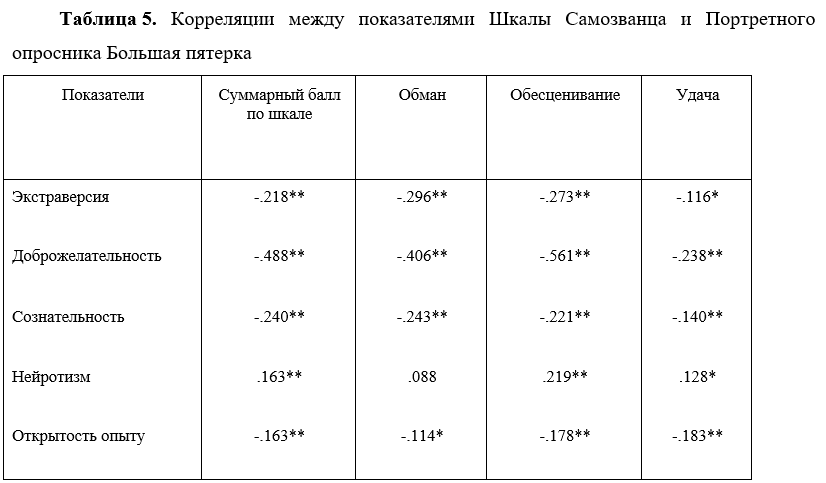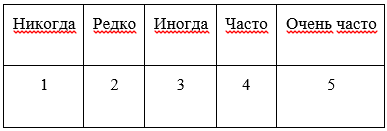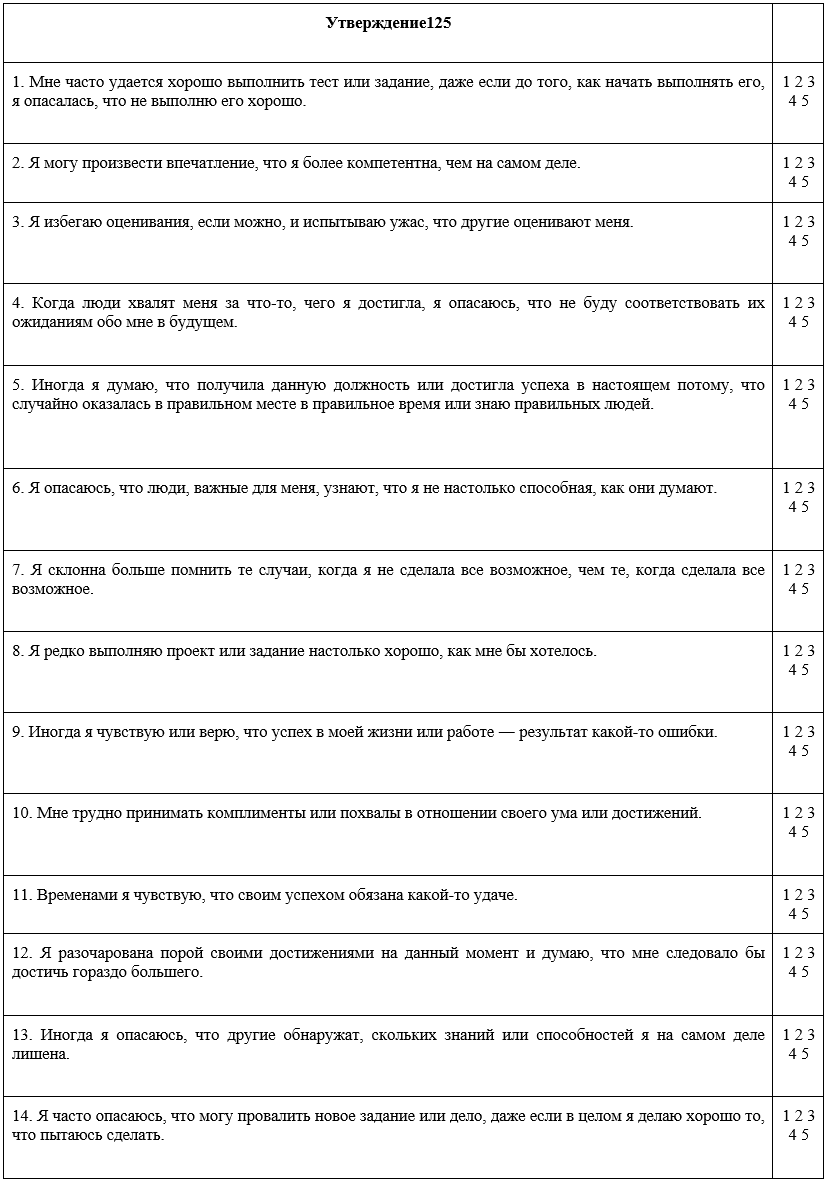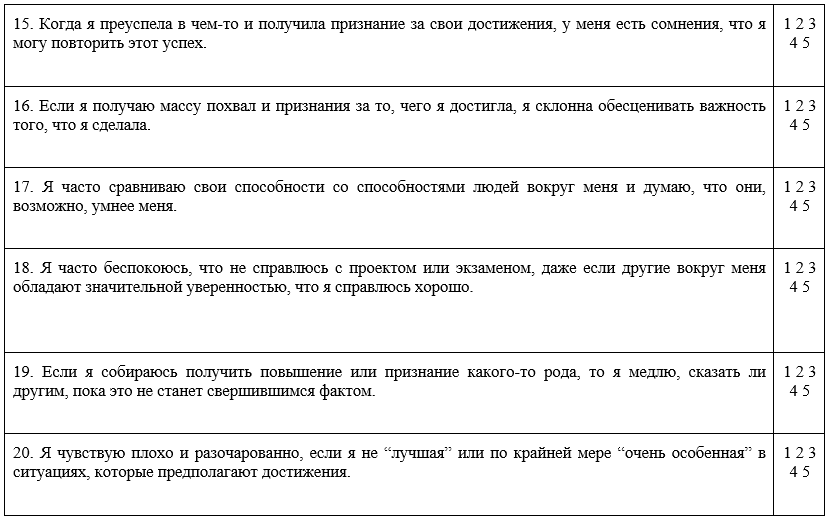- Код статьи
- S020595920013343-3-1
- DOI
- 10.31857/S020595920013343-3
- Тип публикации
- Статья
- Статус публикации
- Опубликовано
- Авторы
- Том/ Выпуск
- Том 42 / № 1
- Страницы
- 132-142
- Аннотация
Феномен самозванца ― личностная диспозиция, описывающая предрасположенность человека к недооценке собственных способностей, компетенций и достижений; непринятие одобрения собственной деятельности со стороны других и преувеличение их достижений; приписывание успеха внешним факторам. Феномен самозванца обнаруживает отрицательные связи с самооценкой, а положительные ― с переживанием негативных эмоций. Цель работы ― апробация “Шкалы феномена самозванца” Паулины Кланс (Clance Impostor Phenomenon Scale). Шкала феномена самозванца включает 20 утверждений, которые теоретически отнесены к трем подшкалам: Обман, Обесценивание и Удача. В исследовании приняли участие 370 студентов. Для оценки внешней валидности шкалы использовались методика исследования самоотношения В.В. Столина, С.Р. Пантилеева и Портретный опросник Большой пятерки. Конфирматорный факторный анализ подтвердил однофакторную структуру опросника. В ходе апробации шкалы феномена самозванца были получены данные, свидетельствующие о ее достаточно высокой надежности (α Кронбаха = 0.89). Валидность методики подтверждается отрицательными корреляциями с показателями самоотношения, четырьмя личностными чертами и положительными корреляциями с внутренней конфликтностью, самообвинением и нейротизмом. Таким образом, Шкала феномена самозванца обладает однофакторной структурой, имеет достаточно высокие показатели надежности и конвергентной валидности, поэтому может применяться для широкого круга исследовательских и прикладных задач.
- Ключевые слова
- феномен самозванца, психодиагностика, валидность, надежность, самоотношение, личность
- Дата публикации
- 20.01.2021
- Год выхода
- 2021
- Всего подписок
- 6
- Всего просмотров
- 735
Первоначально феномен самозванца был описан Паулиной Кланс (P. Clance) в 1978 году в результате систематических наблюдений во время терапевтических сеансов [14]. Феномен самозванца характеризуется внутренней убежденностью человека в том, что его успех зависит исключительно от случайности, внешней ошибки, личного обаяния или усердной работы, но не от способностей или умений. Люди с такой чертой личности опасаются, что не вписываются в окружающую академическую или организационную среду, несмотря на объективную квалификацию и достижения [20, 23].
В монографии П. Кланс 1985 года [13] были сформулированы основные характеристики феномена самозванца, к которым относятся: 1) ощущение того, что собственные способности и компетенции гораздо ниже, чем думают окружающие, и страх перед тем, что реальная ситуация станет всем известна, 2) неспособность объективно оценить результаты собственной деятельности и принять похвалу за них с одновременным переоцениваем достижений других людей, 3) приписывание успеха внешним факторам и неспособность признать собственные достижения.
C 1978 было опубликовано более 1200 исследований, посвященных феномену самозванца, при этом 80% этих работ появилось за последние 20 лет [24]. В одной из первых статей П. Кланс было показано, что данная личностная диспозиция характерна для женщин, занимающих высокие должности или имеющих высокие академические достижения [14]. В последующих исследованиях было обнаружено, что феномен самозванца имеет более широкое распространение [21, 29, 33]. Он характерен для групп расовых и этнических меньшинств [8, 16], сексуальных меньшинств [19], профессиональных групп, где успех не поддается количественному исчислению [28], а также для тех, кто в обществе считается экспертами или специалистами благодаря возрасту или накопленным знаниям [5, 8]. Таким образом, изучение феномена самозванца позволяет рассматривать его как фактор, препятствующий достижениям в конкретной сфере деятельности и ведущий к переживанию негативных эмоциональных состояний. Было показано, что феномен самозванца отрицательно коррелирует с самооценкой [31] и самовосприятием [16], положительно ― с тревожностью и депрессией [6, 26, 30], страхом неудачи [20], и является препятствием в развитии карьеры [27].
Феномен самозванца чаще всего проявляется в новых для человека ситуациях, при принятии новой роли [15] или в начале истории успеха [31]. Он развивается в условиях, когда люди пытаются изменить свое поведение, чтобы их положительно оценивали в новой ситуации или группе [25], в связи с чем данный феномен может стать препятствием вхождения в среду и успешной адаптации. Существуют доказательства того, что развитие феномена самозванца может быть связано с переменными социального положения, изменяющимися контекстуальными факторами и факторами окружающей среды [7].
Предварительный анализ показал, что исследований феномена самозванца в России не проводилось, существует лишь ограниченное количество работ, носящих ознакомительный или описательный характер (для примера см. [1]). В связи с этим исследование психометрических характеристик шкалы измерения феномена самозванца вносит вклад не только в расширение проблемного поля отечественной психологии, но и в возможности практического использования результатов исследования в образовательной, управленческой и консультационной практике.
Диагностический инструмент для измерения феномена самозванца также был разработан П. Кланс [13] — Шкала феномена самозванца (Clance Impostor Phenomenon Scale), которая включает 20 утверждений. Психометрические свойства данной шкалы были изучены в ряде работ, тем не менее вопрос о ее факторной структуре остается открытым. В одном из первых исследований с участием автора шкалы [12] была показана конструктная валидность, дискриминантная валидность и факторная структура шкалы c тремя стабильными факторами (Обман, Обесценивание, Удача). Факторная структура Шкалы феномена самозванца П. Кланс обсуждалась и в более поздних работах. Например, на выборке студентов было показано, что двухфакторная модель может быть лучшим решением, где факторы Обман и Обесценивание были объединены в один, так как имели высокую положительную корреляцию (0.98) [17]. В недавнем исследовании [32] после проверки трехфакторного, двухфакторного и однофакторного решения путем конфирматорного факторного анализа приводятся доказательства в пользу того, что однофакторная модель более приемлемо соответствует данным.
Шкала феномена самозванца была переведена на корейский [11] и немецкий языки [9], при адаптации были получены хорошие психометрических показатели (α = 0.84 и 0.87–89 соответственно).
Кроме шкалы, описанной выше, существует еще три инструмента для измерения синдрома самозванца: 1) шкала феномена самозванца Харви (Harvey) [18], 2) шкала субъективного обмана Коллигиана и Стернберга (Kolligian, Sternberg) [20], 3) шкала самозванца Лири (Leary) [22]. Такое разнообразие шкал объясняется подходами к определению и способами инструментального описания изучаемого феномена. Вместе с тем, Шкала феномена самозванца П. Кланс является наиболее исследованным и надежным измерительным инструментом из существующих на настоящий момент [6, 9, 17].
Общей целью данного исследования является апробация русскоязычной версии Шкалы феномена самозванца П. Кланс (Clance Impostor Phenomenon Scale), а именно установление ее факторной структуры (проверка альтернативной гипотезы об однофакторной структуре), надежности входящих в нее подшкал, конвергентной валидности по отношению к другим шкалам (опросникам), диагностирующим черты, связанные с самоотношением, а также базовыми личностными диспозициями.
МЕТОДИКА
Участники исследования. В исследовании приняли участие 370 студентов 1–4 курсов пермских вузов. Средний возраст респондентов — 19.08 (стандартное отклонение 1.01), доля женщин в выборке — 75%.
Инструменты. В работе используется шкала феномена самозванца П. Кланс (CIPS) [13], включающая 20 утверждений (Пример: “Когда люди хвалят меня за что-то, чего я достиг, я опасаюсь, что не буду соответствовать их ожиданиям обо мне в будущем”). Методика позволяет определить три фактора феномена самозванца ― Обман (“Иногда я опасаюсь, что другие обнаружат, скольких знаний и способностей я на самом деле лишен”, Обесценивание (“Я часто сравниваю свои способности со способностями людей вокруг меня и думаю, что они, возможно, умнее меня”) и Удача (“Временами я чувствую, что своим успехом обязан какой-то удаче”). Утверждения оцениваются респондентами по шкале Ликерта от 1 — никогда, до 5 — очень часто. Авторы данной статьи связались с Паулиной Кланс и получили разрешение на адаптацию Шкалы феномена самозванца. Для подготовки перевода использовался трехэтапный метод Р. Брислина (Brislin) [10]. Перевод утверждений на русский язык осуществлялся Т.М. Пермяковой и М.С. Шевелевой, в верификации обратного перевода участвовали двое анонимных специалистов ― носителей английского языка. Текст опросника и тестовые нормы, разработанные П. Кланс, приводятся в приложении.
В целях исследования внешней валидности использовались:
1. Методика исследования самоотношения (Пантилеев С.Р., Столин В.В.) [3, 4], которая позволяет диагностировать три фактора или модальности самоотношения: самоуважение, аутосимпатия и самоуничижение, каждый из которых содержит отдельные аспекты. В опроснике 110 утверждений, с которыми респондент выражает согласие или несогласие, и 10 шкал. Авторами опросника приводятся данные о ретестовой надежности (корреляция между шкалами 0.72–0.93) [3]. Данная методика использовалась, так как описание шкал является содержательно близким к характеристикам синдрома самозванца, которые описывает П. Кланс [13]. В частности, негативное отношение к себе и собственным достижениям, которое соответствует шкале Самоуверенности и шкале Внутренней конфликтности, неспособность оценить собственные достижения — Отраженному самоотношению, а приписывание успеха внешним факторам — Саморуководству.
2. Портретный опросник Большой пятерки (Егорова М.С., Паршикова О.В.) [2] содержит 10 утверждений, позволяющих измерить пять основных личностных диспозиций (Нейротизм, Экстраверсия, Доброжелательность, Сознательность и Открытость опыту). Портретный опросник демонстрирует удовлетворительные показатели надежности для шкал от 0.61 до 0.84 и конвергентную валидность при сопоставлении с другими методами диагностики Большой пятерки.
Статистическая обработка данных проводилась с помощью программы SPSS 20. Использовались корреляционный анализ, эксплораторный и конфирматорный факторный анализ.
РЕЗУЛЬТАТЫ
Конструктная валидность
Эксплораторный факторный анализ. На основе метода главных компонент было выделено пять факторов, при этом 14 пунктов вошли в первый фактор, 5 вошли в несколько факторов, в связи со сходными значениями факторной нагрузки, и один пункт образовал самостоятельный фактор. Суммарная доля объяснимой дисперсии 57.8%, первый фактор 32.4%, другие факторы меньше 7%. Адекватность применения метода факторного анализа подтверждается значениями коэффициентов Кайзера–Мейера–Олькина (0.91) и значимостью коэффициента сферичности Бартлетта (2365.263, df = 136, p < 0.001).
Применение вращения факторов методом Варимакс позволило выделить три фактора, соответствующие структуре феномена самозванца: Обман, Обесценивание и Удача [9, 13]. Далее было принято решение удалить три вопроса, которые не входили в какой-либо из трех факторов, соответствующих структуре феномена, и образовывали самостоятельные факторы. Подобная процедура была проделана и при адаптации опросника на немецкий язык [9].
В результате следующего шага факторизации и применения вращения была получена факторная структура, состоящая из трех относительно независимых факторов, которые содержательно описывали структуру Шкалы феномена самозванца (см. табл. 1). Таким образом, на уровне эксплораторного факторного анализа можно утверждать, что данный опросник измеряет три составляющих феномена самозванца (Обман, Обесценивание и Удача) при меньшем количестве вопросов.
Конфирматорный факторный анализ. Результаты, полученные при конфирматорном факторном анализе полной версии шкалы (Модель 1), свидетельствуют о том, что однофакторная модель плохо соответствует эмпирическим данным (см. табл. 2). Анализ индексов модификации показал, что среди пунктов шкалы обнаруживаются значимые устойчивые ковариации ошибок. Данные суждения относятся к одной из характеристик феномена самозванца и похожи по содержанию. Ковариации между этими пунктами были добавлены в Модель 2, которая показала большую пригодность. Далее тестировалась Модель 3, из которой были исключены три вопроса, по результатам предварительных анализов показавшие минимальную связь с другими пунктами шкалы. Также тестировалась трехфакторная Модель 4, которая включала меньшее число пунктов и три фактора, соответствующих подшкалам методики (Обман, Обесценивание и Удача). Пригодность Модели 3 оказалась наилучшей.
Примечание: χ2— критерий хи-квадрат, df — число степеней свободы, CFI — сравнительный индекс согласия Бентлера, RMSEA — корень среднеквадратической ошибки аппроксимации, 90% CI — границы доверительного интервала для RMSEA, AIC – информационный критерий Акайке, NFI — нормированный показатель соответствия Бентлера-Бонетта, TLI — ненормированный показатель соответствия Такера–Льюиса. *** — р<0.001.
Дискриминантная валидность. Были подсчитаны корреляции между факторами, входящими в Шкалу феномена самозванца. Наибольшее значение демонстрирует связь между факторами Обман и Обесценивание, а наименьшее ― связь факторов Удача и Обесценивание (см. табл. 3). При таких значениях корреляций между факторами нет достаточных оснований говорить, что они измеряют различные конструкты.
Надежность опросника
Надежность опросника была рассчитана для полной версии (соответствует теоретической модели) и сокращенной версии шкалы (соответствует факторной модели). Общее значение α Кронбаха для полной версии — 0.87, среднее значение корреляций пунктов шкалы с ее суммарным показателем — 0.30 [0.35:0.69], для сокращенной версии шкалы — 0.89, среднее значение корреляций пунктов с суммарным показателем — 0.26 [-0.09:0.67].
При расщеплении пунктов Полной версии шкалы (20 вопросов) на две части коэффициент корреляции между ее частями был равен 0.755, коэффициент надежности α = 0.733 (1 часть); 0,818 (2 часть), статистика Гуттмана ― 0.856. При расщеплении пунктов Сокращенной версии шкалы (17 вопросов) на две части коэффициент корреляции между ее частями был равен 0.734, коэффициент надежности α = 0.820 (1 часть); 0.824 (2 часть), статистика Гуттмана – 0.843.
Несмотря на то, что модель трех факторов показала недостаточную пригодность по результатам конфирматорного анализа, но при этом трехфакторная структура используется в других исследованиях, были подсчитаны коэффициенты надежности α Кронбаха для отдельных шкал опросника. Так, для шкалы Страх α = 0.85, усредненная межпунктовая корреляция 0.589; для шкалы Обесценивание α = 0.74, усредненная межпунктовая корреляция 0.581; для шкалы Удача α = 0.75, усредненная межпунктовая корреляция 0.481.
Внешняя валидность
Внешняя валидность Шкалы феномена самозванца определялась посредством корреляционных связей ее суммарной шкалы и подшкал со шкалами Методики изучения самоотношения и Портретного опросника “Большая пятерка”.
Примечание: ** — значимые корреляции при p < 0.01.
Как видно из таблицы, независимо от того, какой показатель Шкалы феномена самозванца рассматривается (суммарный или показатель подшкалы), величина и значимость коэффициента корреляции является сходной. Это еще раз свидетельствует в пользу того, что Шкала феномена самозванца скорее измеряет единый конструкт, поэтому далее будут рассмотрены только взаимосвязи суммарного балла по Шкале феномена самозванца. Общий балл по шкале отрицательно связан со следующими показателями Методики исследования самоотношения: Закрытость–Открытость, Самоуверенность, Саморуководство, Отраженное самоотношение, Самоценность, Самопринятие, Самопривязанность; положительно связан с показателями Внутренняя конфликтность и Самообвинение.
При анализе связей между показателями Шкалы феномена самозванца были обнаружены значимые корреляции со всеми свойствами пятифакторной модели. Отдельные факторы Шкалы феномена самозванца также обнаружили сходные корреляционные связи с показателями черт личности за исключением связи подшкалы Обман и Нейротизма, таблица 5. Большинство связей с чертами пятифакторной модели личности являются отрицательными, за исключением связей с Нейротизмом. Наибольшее значение коэффициента корреляции обнаруживается у суммарного балла по Шкале феномена самозванца с Доброжелательностью.
Примечание: ** — значимые корреляции при p < 0.01; * — значимые корреляции при p < 0.05.
ОБСУЖДЕНИЕ РЕЗУЛЬТАТОВ
По результатам эксплораторного анализа факторная структура Шкалы феномена самозванца обнаруживает три фактора, составляющих феномен самозванца (Обман, Обесценивание и Удача) в соответствии с теоретическими представлениями П. Кланс [13]. Данная факторная структура частично совпадает с полученной факторной структурой при адаптации шкалы на немецкий язык, в частности, в подшкалу Удача вошли те же вопросы [9]. Однако, обращаясь к другим исследованиям, мы обнаруживаем, что вопрос о количестве подшкал в Шкале феномена самозванца является дискуссионным, так как нет единства в результатах. В частности, в оригинальной англоязычной версии [12] и при адаптации на немецкий язык [9] получены подтверждения трехфакторной структуры опросника. При этом уменьшение количества пунктов в опроснике приводит к получению трехфакторной структуры, что соответствует теоретическому конструкту П. Кланс [24].
По результатам конфирматорного факторного анализа можно утверждать, что наиболее пригодной является сокращенная версия Шкалы с одним фактором. Сравнение с другими исследованиями по адаптации шкалы самозванца или проверки ее структуры показывают разные результаты. Так, авторами немецкой адаптации [9] была принята модель трех факторов (χ2(100) = 225.23 (p < .001), RMSEA = .09, CI[90%] = .08–.11, CFI = .92, TLI = .90) и, хотя ее индексы пригодности близки к полученными нами для трехфакторного решения, тем не менее, в нашем случае модель с меньшим количеством пунктов и одним фактором оказалась более пригодной. В работе Б. Френч (French) [17] обнаружено, что модели с одним и тремя факторами показали низкую пригодность, была принята модель двух факторов (χ2 (61) = 1472.85, p < 0.05, TLI = 0.963, CFI = 0.796), в которой пункты вопросов Обман и Обесценивание образовывали один фактор. В другом исследовании также тестировались модели с разным количеством факторов [32] и было обнаружено, что именно однофакторная модель показывает большую пригодность (GFI = 0.99, NFI = 0.99), чем модель с тремя факторами (GFI = 0.83, NFI = 0.98). Все авторы исследований соглашаются с тем, что структура феномена самозванца, несмотря на ее теоретическое обоснование, требует дополнительного изучения.
При обсуждении моделей с несколькими факторами исследователи ориентируются на корреляции между факторами (дискриминативная валидность) для принятия решения о выборе модели. Как показывают результаты нашего и других исследований, выделяемые факторы показывают высокие значения корреляций, особенно для факторов Обман и Обесценивание. Только в одном исследовании [9] корреляции между факторами были на уровне средних значений коэффициента, что использовалось авторами как аргумент в пользу независимости трех факторов. В большинстве работ получены высокие коэффициенты корреляции между шкалами опросника, что не дает основания для рассмотрения подшкал как независимых и скорее подтверждает близость факторов и пунктов.
Таким образом, целесообразнее рассматривать Шкалу феномена самозванца как одномерную, измеряющую в совокупности различные стороны этого феномена. Использование отдельных подшкал целесообразно только в случае обнаружения существенного расхождения в ответах респондентов по подшкалам Обман, Обесценивание и Удача.
Полученная Шкала феномена самозванца демонстрирует высокие показатели надежности α Кронбаха — 0.89, что совпадает с фактами, полученными в других работах, где α Кронбаха варьирует от 0.85 до 0.96 [11, 17, 32]. Расщепление пунктов шкалы показало также высокие значения α Кронбаха. В целом полученные коэффициенты следует рассматривать как достаточные, совпадающие с имеющимися в аналогичных исследованиях. Учитывая интерес исследователей к трехфакторной структуре, можно констатировать, что надежность отдельных факторов также является высокой, а при сравнении полученных значений с другими исследованиями обнаруживаются сходные величины α Кронбаха: Обман α = 0.83–0.84, Обесценивание α = 0.73–0.79, Удача α = 0.69–0.70 [9, 17].
В отношении внешней валидности Шкалы феномена самозванца можно утверждать, что высокие значения по шкале связаны с низким общим самоотношением, что проявляется в том, что чем выше выражен феномен самозванца, тем в большей степени человек ориентирован на мотивацию социального одобрения, обладает внешним локусом контроля, не удовлетворен собственными возможностями, обладает низкой субъективной ценностью, сомневается в собственных качествах и в способности вызвать уважение у других, присутствует ригидность Я-концепции и неверие в возможность развития себя, при этом возникает неудовлетворенность собой, приводящая в внутреннему конфликту и самообвинению. Результаты, приводимые другими исследованиями, также показывают, что высокие значения по Шкале феномена самозванца связаны с низкой самооценкой, низким уровнем доверия себе и негативной самооценкой [12, 20, 29].
Обсуждая взаимосвязи с чертами личности в пятифакторной модели можно констатировать, что высокие значения Шкалы феномена самозванца связаны с интровертированностью, низкой сознательностью и самоконтролем, негативным отношением к другим и закрытостью к новому, при эмоциональной нестабильности. Возможно, это отражает составляющую внешней социальной оценки в феномене самозванца, то есть ориентации на то, что окружающие скорее будут негативно оценивать достижения человека.
При сравнении наших данных с результатами, полученными при сопоставлении Шкалы феномена самозванца и NEO-PI-R на корейской выборке [11], были обнаружены аналогичные факты о положительных связях Нейротизма и Шкалы феномена самозванца и об отрицательных взаимосвязях с Экстраверсией, Доброжелательностью и Сознательностью.
ВЫВОДЫ
Апробирована русскоязычная версия Шкалы феномена самозванца, направленной на измерение феномена самозванца, проявляющегося в занижении оценок собственных способностей и компетенций и неспособности объективной оценки собственных достижений, внешнем локусе контроля и принятии похвалы за успех.
Проведенный анализ Шкалы феномена самозванца показал, что она: 1) обладает однофакторной структурой, 2) демонстрирует хорошие показатели надежности шкалы, 3) характеризуется удовлетворительными показателями конвергентной валидности по отношению к шкалам других опросников, описывающих сходные характеристики. В целом эти результаты позволяют говорить о возможности применения Шкалы феномена самозванца для измерения характеристик феномена самозванца в неклинических популяциях.
ПРИЛОЖЕНИЕ
Шкала феномена самозванца П. Кланс[1]
Инструкция. Пожалуйста, прочтите каждое утверждение и оцените, насколько оно подходит вам, обведя необходимое число. Лучше, если вы будете отвечать быстро, а не обдумывать тщательно каждый ответ. Для оценки используйте приведенную шкалу.
Обработка результатов. После прохождения теста необходимо сложить все ответы. Если общая сумма 40 и меньше, то респондент не обладает характеристиками самозванца; если общая сумма от 41 до 60, то респондент имеет среднюю степень выраженности феномена самозванца; если общая сумма от 61 до 80, то респондент обладает выраженным характеристиками феномена самозванца; если общая сумма превышает 80, то респондент обладает ярко выраженными характеристиками феномена самозванца. Чем выше общая сумма, тем более выражены характеристики самозванца у респондента. Приводимые нормы обозначены автором шкалы П. Кланс [13].
Библиография
- 1. Булгакова Л.И. “Cиндром самозванца”: история возникновения термина, основные концепции и их трансформация // Психология и психотерапия семьи. 2018. №. 3. С. 30–37.
- 2. Егорова М.С., Паршикова О.В. Психометрические характеристики Короткого портретного опросника Большой пятерки (Б5-10) // Психологические исследования. 2016. Т. 9. № 45. С. 9.
- 3. Пантилеев С.Р., Столин В.В. Методика исследования самоотношения. М.: Смысл, 1993.
- 4. Столин В.В. Самосознание личности. М.: Изд-во Моск. ун-та, 1983.
- 5. Arena D.M., Page N.E. The imposter phenomenon in the clinical nurse specialist role // Image: The Journal of Nursing Scholarship. 1992. V. 24. № 2. P. 121–126.
- 6. Bernard N.S., Dollinger S.J., Ramaniah N.V. Applying the big five personality factors to the impostor phenomenon // Journal of personality assessment. 2002. V. 78. № 2. P. 321–333.
- 7. Bernard D., Neblett E. A culturally informed model of the development of the impostor phenomenon among African American youth // Adolescent Research Review. 2018. V. 3. №. 3. P. 279–300.
- 8. Bernat E. Towards a pedagogy of empowerment: The case of “impostor syndrome” among pre-service non-native speaker teachers in TESOL // English language teacher education and development. 2008. V. 11. № 1. P. 1–8.
- 9. Brauer K., Wolf A. Validation of the German-language Clance impostor phenomenon scale (GCIPS) // Personality and Individual Differences. 2016. V. 102. P. 153–158.
- 10. Brislin R.W. Back-translation for cross-cultural research // Journal of cross-cultural psychology. 1970. V. 1. № 3. P. 185–216.
- 11. Chae J.H., Piedmont R.L., Estadt B.K., Wicks R.J. Personological evaluation of Clance's Imposter Phenomenon Scale in a Korean sample // Journal of personality assessment. 1995. V. 65. № 3. P. 468–485.
- 12. Chrisman S.M., Pieper W.A., Clance P.R., Holland C.L., Glickauf-Hughes C. Validation of the Clance imposter phenomenon scale // Journal of Personality Assessment. 1995. V. 65. № 3. P. 456–467.
- 13. Clance P.R. The impostor phenomenon: Overcoming the fear that haunts your success. Atlanta, GA: Peachtree Publishers, 1985.
- 14. Clance P.R., Imes S.A. The imposter phenomenon in high achieving women: Dynamics and therapeutic intervention // Psychotherapy: Theory, Research & Practice. 1978. V. 15. № 3. P. 241.
- 15. Clark M., Vardeman K.K., Barba S.E. Perceived inadequacy: A study of the imposter phenomenon among college and research librarians // College & Research Libraries. 2014. V. 75. № 3. P. 255–271.
- 16. Cokley K., Awad G., Smith L., Jackson S., Awosogba O., Hurst A., Roberts D. The roles of gender stigma consciousness, impostor phenomenon and academic self-concept in the academic outcomes of women and men // Sex Roles. 2015. V. 73. № 9-10. P. 414–426.
- 17. French B.F., Ullrich-French S.C., Follman D. The psychometric properties of the Clance Impostor Scale // Personality and Individual Differences. 2008. V. 44. № 5. P. 1270–1278.
- 18. Harvey J.C. The Impostor Phenomenon and achievement: A failure to internalize success (Doctoral Dissertation, Temple University, 1981).
- 19. Harvey J.C., Katz, C. If I'm so successful, why do I feel like a fake? The impostor phenomenon. New York: Pocket Books, 1986.
- 20. Kolligian Jr J., Sternberg R.J. Perceived Fraudulence in Young Adults: Is There an “Imposter Syndrome”? // Journal of personality assessment. 1991. V. 56. № 2. P. 308–326.
- 21. Lane J.A. The imposter phenomenon among emerging adults transitioning into professional life: Developing a grounded theory // Adultspan Journal. 2015. V. 14. № 2. P. 114–128.
- 22. Leary M.R., Patton K.M., Orlando A.E., Wagoner Funk W. The impostor phenomenon: Self-perceptions, reflected appraisals, and interpersonal strategies // Journal of personality. 2000. V. 68. № 4. P. 725–756.
- 23. Leonhardt M., Bechtoldt M.N., Rohrmann S. All impostors aren’t alike–differentiating the impostor phenomenon // Frontiers in psychology. 2017. V. 8. P. 1505.
- 24. Mak K.K., Kleitman S., Abbott M.J. Impostor phenomenon measurement scales: A systematic review // Frontiers in psychology. 2019. V. 10. P. 1–15.
- 25. McElwee R.O.B., Yurak T.J. Feeling versus acting like an impostor: Real feelings of fraudulence or self-presentation? // Individual Differences Research. 2007. V. 5. № 3. P. 201–221.
- 26. McGregor L.N., Gee D.E., Posey K.E. I feel like a fraud and it depresses me: The relation between the imposter phenomenon and depression // Social Behavior and Personality: an international journal. 2008. V. 36. № 1. P. 43–48.
- 27. Neureiter M., Traut-Mattausch E. An inner barrier to career development: Preconditions of the impostor phenomenon and consequences for career development // Frontiers in psychology. 2016. V. 7. P. 48.
- 28. Parkman A. The imposter phenomenon in higher education: Incidence and impact // Journal of Higher Education Theory and Practice. 2016. V. 16. № 1. P. 51–60.
- 29. Rohrmann S., Bechtoldt M.N., Leonhardt M. Validation of the impostor phenomenon among managers // Frontiers in psychology. 2016. V. 7. P. 821.
- 30. Ross S.R., Stewart J., Mugge M., Fultz B. The imposter phenomenon, achievement dispositions, and the five factor model // Personality and Individual Differences. 2001. V. 31. № 8. P. 1347–1355.
- 31. Schubert N., Bowker A. Examining the impostor phenomenon in relation to self-esteem level and self-esteem instability // Current Psychology. 2017. P. 1–7.
- 32. Simon M., Choi Y.J. Using factor analysis to validate the Clance Impostor Phenomenon Scale in sample of science, technology, engineering and mathematics doctoral students // Personality and Individual Differences. 2018. V. 121. P. 173–175.
- 33. Sonnak C., Towell T. The impostor phenomenon in British university students: Relationships between self-esteem, mental health, parental rearing style and socioeconomic status // Personality and individual differences. 2001. V. 31. № 6. P. 863–874.
